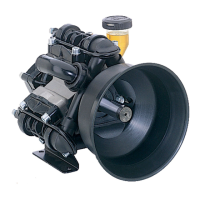7. CLEANING AND MAINTENANCE
Only start cleaning and maintenance once the instructions in the ‘
Only start cleaning and maintenance once the instructions in the ‘Switching offOnly start cleaning and maintenance once the instructions in the ‘
have been completed, i.e.
no part of the pump must be in motion and no pipe must contain
It is particularly important to always disconnect the electricity supply, if present.
Follow the instructions in the
section and abide by the recommendations
INTERVAL FOR MAINTENANCEINTERV
Check the level and the status of the oil.
Check the water intake filter
Check the accumulator inflation
Check the water intake cir
that incorporates the pump.
Should the pump not be fastened secur
do not use the machine under any
a Skilled Technician (1)a Skilled T
equently if the pump operates in cir
with heavy vibrations (crawler tractors, combustion engines, etc.).
During use, the pump should not be too noisy and large amounts of water or oil should not drip
In this event, a Skilled Technician should test the appliance.
The rupture of one or more diaphragms can result in the mechanical parts of the pump being
damaged by the liquids being pumped.
The following are symptoms of possible diaphragm rupture:
oil takes on a whitish appearance (symptom of water in the oil)
excessive consumption of oil
sudden lack of oil in the volumetric compensator
To avoid the negative consequences of this malfunction, stop operation of the pump immediately
without delay (within 24 hours) who will take the necessary
If it is not possible to contact a
within the above time in case of diaphragm
rupture, we recommend you drain the pump crankcase of the mixed oil and pumped liquid and
then ll it with oil or diesel to prevent the formation of rust.
The following are frequently the causes of diaphragm rupture:

